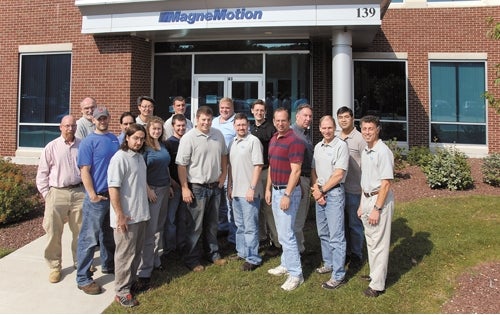A large diagnostic testing laboratory might receive 40,000 specimens for analysis every day. Delivering each specimen to the right stations for the ordered tests can be a complicated process.
A new intelligent transport system from Devens-based MagneMotion could rapidly deliver each specimen to the correct stations, increasing the lab’s efficiency. The new system, called MagneMover LITE, offers an alternative to conventional conveyors, suitable for applications such as manufacturing and automated laboratory operations.
A MagneMover LITE system consists of a guideway or track made up of modular sections, a number of carriers (called vehicles) and the necessary control electronics. Each vehicle is a little over 2 inches square and can carry a test tube or other small payload, up to 1 kilogram (2.2 pounds); a tandem vehicle can carry up to 2 kilograms (4.4 pounds).
The operating principle of MagneMotion’s products is a linear synchronous motor. A conventional electric motor consists of a cylindrical stationary part on the outside and a moving part inside, which rotates.
A linear synchronous motor is something like a conventional motor “unwrapped” so the stationary part of the motor is a long, flat strip containing electrical windings. The moving part, the vehicle, is relatively small and has permanent magnets on its underside.
In the MagneMover LITE, a control system senses where each vehicle is and knows how and where it needs to move along the stationary guideway. Electric current driven into the windings produces a magnetic field, and “the vehicle rides the magnetic field much like a surfer rides a wave,” said Todd Webber, president and CEO.
Motion Technology
MagneMotion is a privately held technology company that concentrates on electromagnetic applications: linear synchronous motors and maglev (magnetic levitation) technology — propulsion, levitation and guidance.
Founded in 1996, MagneMotion employs 65 people and occupies a 43,000-square-foot engineering and production facility.
Since 2005, MagneMotion has manufactured its original intelligent transport system, QuickStick, which has can carry goods ranging from just over 2 pounds to 10,000 pounds. Two-and-a-half years ago, at a laboratory automation trade show, MagneMotion staff noticed applications for a smaller version of QuickStick.
“There appeared to be a demand for something that could move payloads down around a kilogram. This was a market we were missing,” said Nathan King, project manager and systems engineer at MagneMotion.
The engineering department prototyped a new product using a 2.36-inch vehicle. “We demonstrated not only that the physics would work, but that we could create the necessary electronics and magnetics,” King said.
And the MagneMover LITE was born. Next, the company told potential customers about the new product and asked how much they would be willing to pay for it.
“Then we went back to the engineers and said, ‘Can you do it for that?’” Webber said. MagneMotion committed engineering resources to develop the new product. “Starting a year-and-a-half ago, we have had 20 or more people working on it at any given time,” Webber said.
Unlike conventional conveyors, MagneMover LITE allows the user to simply specify the destination and then the system finds the shortest route there. “It’s like a taxi with a dispatcher,” Webber said.
Meanwhile, the system assigns an identity to each vehicle and keeps track of it throughout the system. Many of the obstacles to product development have been in making MagneMotion’s synchronous linear motor technology work in much smaller dimensions.
“It’s been a packaging challenge to fit all the electronics in close proximity to the magnetics,” King said. “There’s not a lot of room to spare, not a lot of room for error on this project. That’s always been challenging — you’re always reaching your boundaries at every turn.”
Some would say it’s risky to undertake a major new product development during an economic downturn. In this case, though, the market was clearly there for the smaller intelligent transport system.
Still, “one of the risks is there’s nothing like it out there,” King said. “It’s a paradigm shift in how you set up your automation systems.”
Fortunately, Webber said, customer experience with QuickStick demonstrates the advantages of an intelligent transport system. For example, a cosmetics manufacturer started using QuickStick and increased throughput by 20 percent without making any additional changes.
“The current projection is to ship the MagneMover LITE at the end of the first quarter 2011,” said Webber. “Of course, we’re still receiving feedback from beta test sites and discovering features to include.”
For future development, the company plans to build upon the MagneMover LITE technology so it can operate in high- or low-temperature environments, to carry heavier payloads and to provide guideways that cover vertical distances as well as horizontal ones.
Barbara Donohue is a freelance writer based in Acton.

